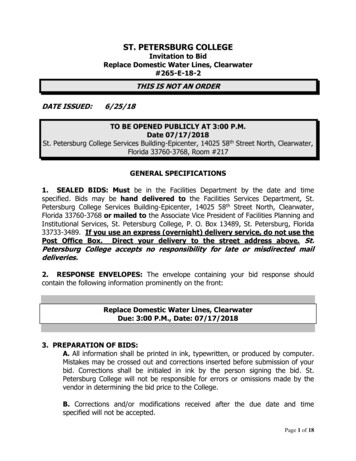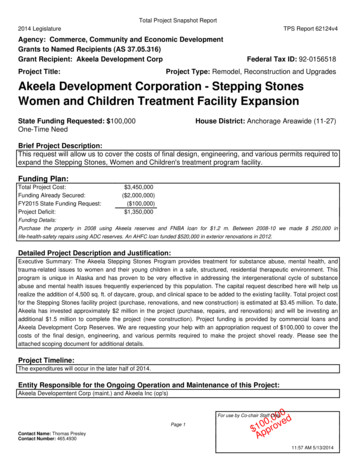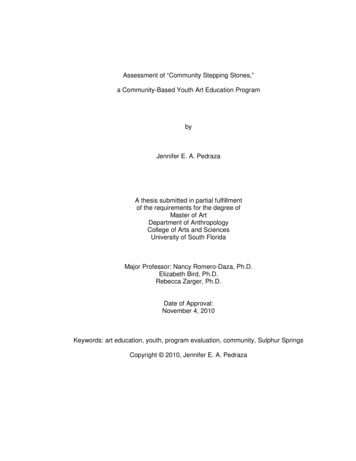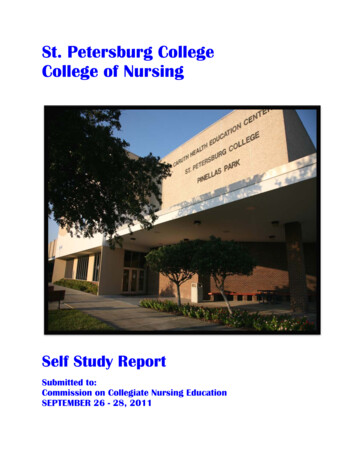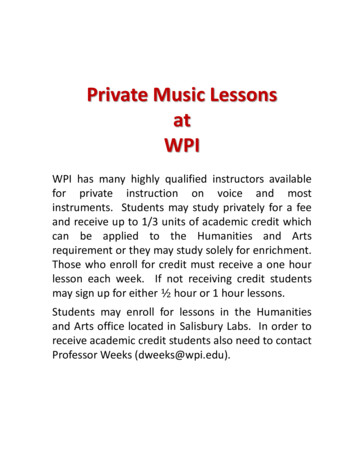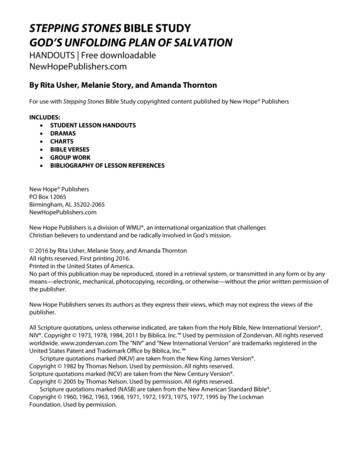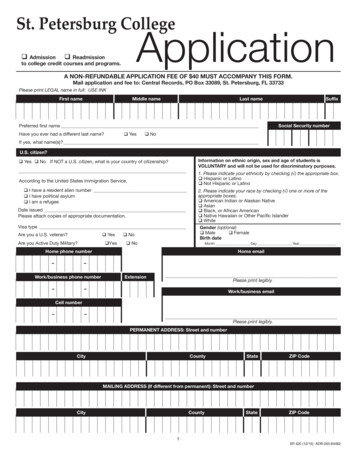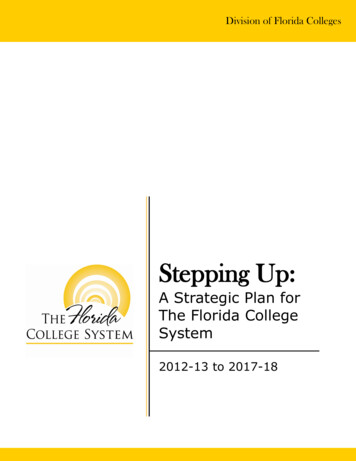
Transcription
Division of Florida CollegesStepping Up:A Strategic Plan forThe Florida CollegeSystem2012-13 to 2017-18
Table of ContentsIntroduction4Dashboard of Key Performance Indicators5Mission and Program Offerings6Performance Indicators9Appendix A: Data Notes for Performance Indicators13Appendix B: Florida College System Institution Missions17Appendix C: Inventory of Program Offerings22Appendix D: Key Initiatives262The Division of Florida CollegesStepping Up: A Strategic Plan for The Florida College System, 2012-13 to 2017-18
Map of Colleges in The Florida College System1.2.3.4.5.6.7.Brevard Community College, CocoaBroward College, Fort LauderdaleChipola College, MariannaCollege of Central Florida, OcalaDaytona State College, Daytona BeachEdison State College, Fort MyersFlorida State College at Jacksonville,Jacksonville8. Florida Keys Community College, Key West9. Gulf Coast State College, Panama City10. Hillsborough Community College, Tampa11. Indian River State College, Fort Pierce12. Florida Gateway College, Lake City13. Lake-Sumter State College, Leesburg14. State College of Florida, Manatee-Sarasota,Bradenton15. Miami Dade College, Miami16. North Florida Community College, Madison17. Northwest Florida State College, Niceville18. Palm Beach State College, Lake Worth19. Pasco-Hernando Community College, NewPort Richey20. Pensacola State College, Pensacola21. Polk State College, Winter Haven22. St. Johns River State College, Palatka23. St. Petersburg College, St. Petersburg24. Santa Fe College, Gainesville25. Seminole State College of Florida, Sanford26. South Florida State College, Avon Park27. Tallahassee Community College, Tallahassee28. Valencia College, Orlando3The Division of Florida CollegesStepping Up: A Strategic Plan for The Florida College System, 2012-13 to 2017-18
IntroductionThe Florida College System is the primary access point to undergraduateeducation for Floridians, including recent high school graduates andreturning adult students. The Florida College System responds quickly andefficiently to meet the demand of employers by aligning certificate anddegree programs with regional workforce needs. With an array of programsand services, The Florida College System’s 28 institutions serve individuals,communities, and the state with low cost, high quality educationopportunities.With a need to increase the proportion of Floridians with college-levelcredentials, The Florida College System will rise to the completion challenge.The economic recovery in Florida and the welfare of its workforce will, inpart, depend on how well The Florida College System steps up to thischallenge. As a system, we are committed to improving completion rates forall students, necessitating a shift from a traditional access-oriented focus toa more comprehensive approach aimed at student success.Higher education in Florida is transforming – bettercollaboration, greater efficiencies, and heightenedtransparency and accountability – and The FloridaCollege System is at the nexus, fostering economicdevelopment and embracing innovation.Setting an aggressive and transformative“student success” agenda for the next fiveyears, The Florida College System hasadopted the following four goals asthe core of our Strategic Plan:4The Division of Florida CollegesStepping Up: A Strategic Plan for The Florida College System, 2012-13 to 2017-18
Dashboard of Key Performance IndicatorsGlobally Competitive tainAccessPerformanceIndicatorBaseline2017-18 TargetAverage wages ofgraduatesStatewide overall: 40,731Statewide overall: 43,238Career Certificate: 37,984College Credit Certificate: 37,184AAS: 41,732AS: 46,604AA: 31,948Bachelors: 48,936Career Certificate: 40,319College Credit Certificate: 39,471AAS: 44,300AS: 49,471AA: 33,913Bachelors: 51,946Percentage ofgraduates foundemployedStatewide overall: 65.0%Statewide overall: 72.9%Career Certificate: 76.7%College Credit Certificate: 72.7%AAS: 83.3%AS: 86.3%AA: 53.0%Bachelors: 88.2%Career Certificate: 84.5%College Credit Certificate: 82.0%AAS: 87.2%AS: 91.2%AA: 58.2%Bachelors: 91.7%Transfer rates ofassociate degreegraduatesTransfers enrolled in SUS50.7%Transfers in FCS upper division7.6%35.0% of Cohort Graduate in 150%time93,285Transfers enrolled in SUS53.7%Transfers in FCS upper division15.4%36.9% of Cohort Graduate in 150%time124,596Retention ratesAA Retention Rate: 66.7%AAS/AS Retention Rate: 58.8%AA Retention Rate: 70.8%AAS/AS Retention Rate: 63.2%Developmentaleducation successMathematics31.8%English62.4%Mathematics & s & English24.8%Success intraditional/campusbased, online/distancelearning, or istance .5%Online/Distance Learning73.5%Hybrid73.5%Students enrollingfollowing high schoolgraduation35.5%37.6%Graduation rateDegrees andcertificates awarded5The Division of Florida CollegesStepping Up: A Strategic Plan for The Florida College System, 2012-13 to 2017-18
Mission and Program OfferingsIn 2012, The Florida College System’s Council of Presidents approved thefollowing mission statement for the system, in addition to the statutorymission:The mission of The Florida College System is to provide access tohigh-quality, affordable academic and career education programsthat maximize student learning and success, develop a globallycompetitive workforce, and respond rapidly to diverse state andcommunity needs.Section (s.) 1004.65, Florida Statutes (F.S.), establishes the primarymission and responsibility of Florida College System institutions asresponding to community needs for postsecondary academic education andcareer degree education.This mission and responsibility includes:(a) Providing lower level undergraduate instruction and awardingassociate degrees.(b) Preparing students directly for careers requiring less thanbaccalaureate degrees. This may include preparing for job entry,supplementing of skills and knowledge, and responding to needs in newareas of technology. Career education in a Florida College Systeminstitution shall consist of career certificates, credit courses leading toassociate in science degrees and associate in applied science degrees,and other programs in fields requiring substantial academic work,background, or qualifications. A Florida College System institution mayoffer career education programs in fields having lesser academic ortechnical requirements.(c) Providing student development services, including assessment,student tracking, support for disabled students, advisement, counseling,financial aid, career development, and remedial and tutorial services, toensure student success.(d) Promoting economic development for the state within each FloridaCollege System institution district through the provision of specialprograms, including, but not limited to:6The Division of Florida CollegesStepping Up: A Strategic Plan for The Florida College System, 2012-13 to 2017-18
Mission and Program Offerings1.2.3.4.Enterprise Florida-related programs.Technology transfer centers.Economic development centers.Workforce literacy programs.(e) Providing dual enrollment instruction.(f) Providing upper level instruction and awarding baccalaureatedegrees as specifically authorized by law.A separate and secondary role for Florida College System institutionsincludes the offering of programs in:(a) Community services that are not directly related to academic oroccupational advancement.(b) Adult education services, including adult basic education, adultgeneral education, adult secondary education, and General EducationalDevelopment test instruction.(c) Recreational and leisure services.In addition, s. 1007.33(2), F.S., requires that any Florida College Systeminstitution that offers one or more baccalaureate degree programs:(a) Maintain as its primary mission:1. Responsibility for responding to community needs forpostsecondary academic education and career degreeeducation as prescribed in s. 1004.65(5), F.S.2. The provision of associate degrees that provide access to auniversity.(b) Maintain an open-door admission policy for associate-level degreeprograms and workforce education programs.7The Division of Florida CollegesStepping Up: A Strategic Plan for The Florida College System, 2012-13 to 2017-18
Mission and Program Offerings(c) Continue to provide outreach to underserved populations.(d) Continue to provide remedial education.(e) Comply with all provisions of the statewide articulation agreementwhich relate to 2-year and 4-year public degree-granting institutions asadopted by the State Board of Education pursuant to s. 1007.23, F.S.*A Florida College System institution, with approval from its Board ofTrustees, may establish a separate mission; however, the primary missionand responsibilities identified in s. 1004.65, F.S., are inherent to theinstitution mission. Responsibilities of Florida College System institutionsinclude offering the associate in arts degree programs and associate inscience degree programs. Depending on local workforce and communityneeds, Florida College System institutions may offer associate in appliedscience degree programs in select fields and, with approval from the StateBoard of Education, bachelor degree programs in select fields.* (f) Not award graduate credit.(g) Not participate in intercollegiate athletics beyond the 2-year level.8The Division of Florida CollegesStepping Up: A Strategic Plan for The Florida College System, 2012-13 to 2017-18
Performance IndicatorsPERFORMANCE INDICATOR2017-18 TARGETBASELINEGoal 1: Expand and Maintain Access1.1Number of high school studentsparticipating in dual enrollment58,78246,0832010-111.2Number of students enrolled in collegecredit courses in the FCS disaggregatedby age rangeStatewide overall: 478,130Statewide overall: 505,532Under 18-21: 225,95122-29: 135,18730-39: 64,01440-64: 51,777Other: 1,201Under 18-21: 240,57322-29: 136,39930-39: 71,34640-64: 56,007Other: 1,2072011-121.3.1 1.3.21.3.31.41.5Percentage of students who enroll in theyear following high school graduation35.5%37.6%2010-11Of students who enroll in the yearfollowing high school graduation,percentage of minority students54.1%Of students who enroll in the yearfollowing high school graduation,percentage of low income students64.2%Percentage of degree-seeking studentsclassified as non-Florida residents fortuition purposes3.7%Average net price of attending a FCSinstitution 6,51159.5%2011-1265.8%2011-124.9%2010-11 6,5112009-101.6Number of students enrolled incommunity education programsContinuing Workforce Education151,948Recreation and Leisure57,761Tuition remains level. State fundscover inflation and cost increases.Continuing Workforce Education182,992Recreation and Leisure63,4662010-119The Division of Florida CollegesStepping Up: A Strategic Plan for The Florida College System, 2012-13 to 2017-18
Performance IndicatorsPERFORMANCE INDICATOR2017-18 TARGETBASELINEGoal 2: Enhance Distance Learning2.1Percentage of students enrolled in anonline/distance learning course33.1%36.2%2010-112.2 Percentage of students earning a grade“C” or better in traditional/campusbased, online/distance learning, orhybrid e .5%Online/Distance Learning73.5%Hybrid73.5%2010-11Goal 3: Increase College Readiness and Success3.1 Percentage of developmental educationcompleters who complete college-levelcourse in same subject with a “C”grade or above within 2 yearsMathematics31.8%English62.4%Mathematics & s & English24.8%2007-083.2Number of institutional and programrankingsInstitutional rankings: 128Program rankings: 56Institutional rankings: 157Program rankings: 842011-123.3Number of faculty receiving awards7438122011-123.43.5Percentage of students receivingfederal, state, local, institutional, orother sources of grant aid52.7%55.7%Percentage of students receivingFederal student loans and averageamount of Federal student loan aidreceived by undergraduate studentStudents Receiving Loans19.4%Average Amount of LoanReceived 5,4182010-11Students Receiving Loans17.4%Average Amount of LoanReceived 5,9242010-113.6Cohort default rate for FCS12.9%10.7%2008-0910The Division of Florida CollegesStepping Up: A Strategic Plan for The Florida College System, 2012-13 to 2017-18
Performance IndicatorsPERFORMANCE INDICATOR2017-18 TARGETBASELINEGoal 3: Increase College Readiness and Success3.7 3.8 3.93.10Retention ratesAA Retention Rate: 66.7%AAS/AS Retention Rate: 58.8%AA Retention Rate: 70.8%AAS/AS Retention Rate: 63.2%Fall 2007-Spring 2011Number of degrees and certificatesawarded93,285124,5962010-11Graduation rate for first-time incollege students (150% time)35.0% of Cohort Graduate in150% time36.9% of Cohort Graduate in150% time2010-11Average time and credit to associatedegreeTime to DegreeAccelerated students: 2.8 yearsNon-Accelerated Students: 4.4yearsTime to DegreeAccelerated students: 2.6 yearsNon-Accelerated Students: 4.2yearsCredit to DegreeAccelerated students: 73 creditsNon-Accelerated Students: 78creditsCredit to DegreeAccelerated students: 68 creditsNon-Accelerated Students: 73credits2009-103.11 3.12Transfer rates of associate degreegraduates who transfer within twoyears to the upper division at a FloridaCollege System institution or stateuniversityTransfers enrolled in SUS50.7%Transfers in FCS upper division7.6%Percentage of students taking andpassing licensure examsNCLEX-RN (Registered Nurse)89.7%NCLEX-PN (Practical Nurse)88.6%Transfers enrolled in SUS53.7%Transfers in FCS upper division15.4%2008-09 CompletersNCLEX-RN (Registered Nurse)90.7%NCLEX-PN (Practical Nurse)90.1%2010-1111The Division of Florida CollegesStepping Up: A Strategic Plan for The Florida College System, 2012-13 to 2017-18
Performance IndicatorsPERFORMANCE INDICATOR2017-18 TARGETBASELINEGoal 4: Prepare for Careers4.1 Percentage of graduates foundemployed in the state of Florida withinone year of completion disaggregatedby certificate/degree typeStatewide overall: 65.0%Statewide overall: 72.9%Career Certificate: 76.7%College Credit Certificate: 72.7%AAS: 83.3%AS: 86.3%AA: 53.0%Bachelors: 88.2%Career Certificate: 84.5%College Credit Certificate: 82.0%AAS: 87.2%AS: 91.2%AA: 58.2%Bachelors: 91.7%2009-104.2 Average wages of graduates foundemployed in the state of Florida withinone year of completion disaggregatedby certificate/degree typeStatewide overall: 40,731Statewide overall: 43,238Career Certificate: 37,984College Credit Certificate: 37,184AAS: 41,732AS: 46,604AA: 31,948Bachelors: 48,936Career Certificate: 40,319College Credit Certificate: 39,471AAS: 44,300AS: 49,471AA: 33,913Bachelors: 51,9462009-10 Denotes Key Performance Indicators.12The Division of Florida CollegesStepping Up: A Strategic Plan for The Florida College System, 2012-13 to 2017-18
Appendix A: Data Notes for Performance IndicatorsGoal 1: Expand and Maintain Access1.1 Number of high school students participating in dual enrollment Descriptor: Unduplicated headcount by course enrollment (total dual enrolled),2010-11 Source: Community College & Technical Center MIS (CCTCMIS)1.2 Number of students enrolled in college credit courses in the FCSdisaggregated by age range Descriptor: Fall headcount enrollment for full-time and part-time students enrolledfor credit by age ranges, 2011-12. Note: the target is the statewide overall number;the breakout categories are informational Source: CCTCMIS, 2012 Fact Book1.3.1 Percentage of students who enroll in the year following high schoolgraduation Descriptor: 2009-10 high school diploma recipients who enroll in FCS, 2010-11 Source: CCTCMIS1.3.2 Of students who enroll in the year following high school graduation,percentage of minority students Descriptor: 2011-12. The denominator of 1.3.2 is the numerator from 1.3.1 Source: CCTCMIS1.3.3 Of students who enroll in the year following high school graduation,percentage of low income students Descriptor: 2011-12. The denominator of 1.3.3 is the numerator from 1.3.1 Source: CCTCMIS1.4 Percentage of degree-seeking students classified as non-Floridaresidents for tuition purposes Descriptor: Dual enrolled, adult general education, and continuing workforceeducation students excluded, 2010–11 Source: CCTCMIS, College Student Data Base1.5 Average net price of attending a FCS institution Descriptor: 2009-10 Source: U. S. Department of Education (USDOE), College Affordability andTransparency Center1.6 Number of students enrolled in community education programs Descriptor: 2010–11, continuing workforce education and recreation and leisure Source: CCTCMIS, 2012 Fact Book13The Division of Florida CollegesStepping Up: A Strategic Plan for The Florida College System, 2012-13 to 2017-18
Appendix A: Data Notes for Performance IndicatorsGoal 2: Enhance Distance Learning2.1 Percentage of students enrolled in an online/distance learning course Descriptor: Of the students enrolled in a course, unduplicated headcount ofstudents in distance learning courses, 2010-11. Calculation: “C” or better divided bytotal in each course delivery type Source: CCTCMIS, Personnel Data Bases2.2 Percentage of students earning a grade “C” or better in traditional/campus-based, online/distance learning, or hybrid courses Descriptor: Course grades by course type, 2010–11 Source: CCTCMIS, Personnel Data BasesGoal 3: Increase College Readiness and Success3.1 Percentage of developmental education completers who completecollege-level course in same subject with a “C” grade or above within 2years Descriptor: Total first time entry students, 2007-08 Source: CCTCMIS3.2 Number of institutional and program rankings Descriptor: 28 colleges reported rankings, 2011-12 Source: Self-reported3.3 Number of faculty receiving awards Descriptor: 28 colleges reported rankings, 2011-12 Source: Self-reported3.4 Percentage of students receiving federal, state, local, institutional, orother sources of grant aid Descriptor: 2010-11 Source: Integrated Postsecondary Education Data System (IPEDS)3.5 Percentage of students receiving Federal student loans and averageamount of Federal student loan aid received by undergraduate students Descriptor: 2010-11 Source: IPEDS3.6 Cohort Default Rate for FCS Descriptor: Official Two-Year Default Rate, 2008-09 Source: USDOE, Default Prevention and Management14The Division of Florida CollegesStepping Up: A Strategic Plan for The Florida College System, 2012-13 to 2017-18
Appendix A: Data Notes for Performance IndicatorsGoal 3: Increase College Readiness and Success3.7 Retention rates Descriptor: Retention rate (Number of students who have graduated numberof students who are enrolled and in good academic standing number of studentswho are enrolled and who are not in good academic standing) divided by thenumber of students in the cohort pool, 2011 Source: CCTCMIS3.8 Number of degrees and certificates awarded Descriptor: 2010-11 Source: CCTCMIS, 2012 Fact Book3.9 Graduation rate for first-time in college students (150% time) Descriptor: Represents full-time, first-time degree or certificate seekingundergraduates, 2007 cohort. 150% (3 years) Source: Southern Regional Education Board (SREB) State Data Exchange 201011 Indicators Report, January 20123.10 Average time and credit to associate degree Time to degree Descriptor: Accelerated students who have earned college credit throughacceleration mechanisms, such as dual enrollment. SREB average years todegree at college awarding associates degrees, 2009-10. Note: FCSaccelerated students are tied for 1st among SREB states and non-acceleratedstudents are 2nd among SREB states Source: SREB State Data Exchange, Table 63, January 2012 Credit to degree Descriptor: Accelerated students who have earned college credit throughacceleration mechanisms, such as dual enrollment. Average creditsattempted at college awarding associates degrees, 2009-10. Note: FCSaccelerated and non-accelerated students are 3rd among SREB states Source: SREB State Data Exchange, Table 75, January 20123.11 Transfer rates of associate degree graduates who transfer within twoyears to the upper division at a Florida College System institution or stateuniversity Descriptor: 2008-09 degree completers that were found enrolled in the 2008-09,2009-10, & 2010-11 in upper division of FCS and State University System Source: CCTCMIS3.12 Percentage of students passing licensure exams Descriptor: Percentage of first time candidates who pass the exam, 2010-11 Source: Florida Department of Health, Division of Medical Quality Assurance15The Division of Florida CollegesStepping Up: A Strategic Plan for The Florida College System, 2012-13 to 2017-18
Appendix A: Data Notes for Performance IndicatorsGoal 4: Prepare for Careers4.1 Percentage of graduates found employed in the state of Florida withinone year of completion disaggregated by certificate/degree type Descriptor: 2009-10 Completers, Fall 2010 Findings. Note: the target is thestatewide overall percentage; the breakout categories are informational Source: Florida Education and Training Placement Information Program (FETPIP)Annual Outcomes Report4.2 Average wages of graduates found employed in the state of Floridawithin a year of completion disaggregated by certificate/degree type Descriptor: Average full-time, full-quarter earnings, 2009-10 Completers, Fall2010 Findings. Note: Many AA students go on to continue their education, whichcould contribute to the lower salary compared to other graduates. Additionally, thetarget is the statewide overall number; the breakout categories are informational Source: FETPIP Annual Outcomes Report16The Division of Florida CollegesStepping Up: A Strategic Plan for The Florida College System, 2012-13 to 2017-18
Appendix B: FCS Institution MissionsThe following statements are excerpts from institutional missions.Brevard Community CollegeTo engage our diverse population in quality, accessible, learning opportunities whichsuccessfully meet individual and community needs.Broward CollegeThe mission of Broward College is to achieve student success by developinginformed and creative students capable of contributing to a knowledge- and servicebased global society. As a public community college accredited to offer associatedegrees, selected baccalaureate degrees, and certificate programs, the institutionand its District Board of Trustees are committed to fostering a learning-centeredcommunity that celebrates diversity and inclusion by empowering and engagingstudents, faculty, and staff.Chipola CollegeChipola is a comprehensive public college whose mission is to provide accessible,affordable, quality educational opportunities to the residents of Calhoun, Holmes,Jackson, Liberty and Washington counties and to all others who choose to attend.The college creates a student-oriented atmosphere of educational excellence andmaintains an intellectual environment which inspires the full development of eachindividual’s goals, abilities, and interests. Because there is no substitute for qualityinstruction, the college empowers faculty members to establish and achieve thehighest possible standards. The college also promotes a strong working relationshipwith communities, businesses, state agencies, and other educational institutions.College of Central FloridaCollege of Central Florida offers educational opportunities which are accessible,affordable and high quality. In a climate that nurtures excellence, CF providesundergraduate instruction and awards associate degrees, baccalaureate degreesand certificates; prepares students for careers requiring professional and technicaltraining; encourages student success through a variety of support services; andpromotes the economic, social and cultural development of the community.Daytona State CollegeDaytona State College, a comprehensive public college, provides access to a rangeof flexible programs from community enrichment to the baccalaureate degree,emphasizing student success, embracing excellence and diversity, as well asfostering innovation to enhance teaching and learning.Edison State CollegeThe mission of Edison State College is to inspire learning; prepare a diversepopulation for creative and responsible participation in a global society; and serveas a leader for intellectual, economic, and cultural awareness in the community.17The Division of Florida CollegesStepping Up: A Strategic Plan for The Florida College System, 2012-13 to 2017-18
Appendix B: FCS Institution MissionsFlorida Gateway CollegeThe mission of Florida Gateway College is to provide superior instruction, nurtureindividual development, and enrich the community through quality higher educationprograms and lifelong learning opportunities.Florida Keys Community CollegeFlorida Keys Community College is an open-access, educational institution dedicatedto serving the intellectual, diverse, cultural, and occupational needs of the FloridaKeys as well as the global community. The college is committed to student-centricacademic programs and services, workforce development, continuing education,diverse partnerships, electronically delivered instruction, and sustainable practicesthat prepare students for personal success and responsible citizenship.Florida State College at JacksonvilleThe mission of Florida State College at Jacksonville is to provide optimal access tohigh quality, affordable and relevant degree, career and community education toenhance the lives of our students and the economic development of NortheastFlorida.Gulf Coast State CollegeGulf Coast State College holds students and community of central importance. Thecollege provides many opportunities for learning and offers a range of programsand services to help students become well-educated, productive citizens. Thecollege is equally dedicated to collaborating with the community to help create orimprove economic well-being and to offer the space of the college for social dialog,events of art and culture, and other moments that enhance our quality of life.Hillsborough Community CollegeHillsborough Community College, a public, comprehensive institution of highereducation, empowers students to excel through its superior teaching and service inan innovative learning environment.Indian River State CollegeIndian River State College is a comprehensive college accredited to awardBaccalaureate Degrees, Associate Degrees, and Career and Technical Certificates.As a leader in education and innovation, IRSC transforms lives by offering highquality, affordable and accessible education to the residents of Indian River, Martin,Okeechobee, and St. Lucie counties through traditional and electronic delivery.18The Division of Florida CollegesStepping Up: A Strategic Plan for The Florida College System, 2012-13 to 2017-18
Appendix B: FCS Institution MissionsLake-Sumter State CollegeLake-Sumter State College is a public, multi-campus college offering associatedegrees and certificates that prepare students for employment, careeradvancement, and four-year college or university transfer, and specialized trainingfor business and industry that improves the workforce. Through its commitment tostudent success, LSSC provides students with an accessible, supportive, learningcentered environment while challenging them to think critically, increase theirinformation fluency, communicate effectively, become independent, build leadershipskills, improve their ability to work as part of a team, develop social responsibility,and enhance their creativity.Miami Dade CollegeThe Mission of Miami Dade College is to change lives through the opportunity ofeducation. As democracy’s college, MDC provides high-quality teaching and learningexperiences that are accessible and affordable to meet the needs of our diversestudents and prepare them to be responsible global citizens and successful lifelonglearners. The College embraces its responsibility to serve as an economic, culturaland civic beacon in our community.North Florida Community CollegeNorth Florida Community College provides quality teaching and learningopportunities for individual and community development in a changing society.Northwest Florida State CollegeNorthwest Florida State College improves lives. We deliver outstanding educationalprograms that are relevant, accessible, and engaging for students of all ages andprovide exceptional cultural, athletic, and economic development activities for thecommunities served. We commit to excellence, creativity, integrity, and service.Palm Beach State CollegePalm Beach State College’s mission is to create and sustain a dynamic teaching andlearning environment that provides a high-quality, accessible, affordable education,preparing students to contribute and compete ethically and successfully in a diverseglobal community.Pasco-Hernando Community CollegePasco-Hernando Community College (PHCC) serves the educational needs andinterests of our community. As a comprehensive, multi-campus educationalinstitution, PHCC provides an accessible, diverse teaching and learning environmentrich with opportunities for students to attain academic success and cultural growthin a global society.19The Division of Florida CollegesStepping Up: A Strategic Plan for The Florida College System, 2012-13 to 2017-18
Appendix B: FCS Institution MissionsPensacola State CollegePensacola State College, under the governance of a local Board of Trustees, is oneof 28 public colleges in the Florida College System committed to affordable, openaccess to educational opportunities. The college offers associate and baccalaureatedegrees, career oriented certificates, college prep, adult education, GED prep, andstandard high school diplomas. In addition, the
Pensacola State College, Pensacola 21. Polk State College, Winter Haven 22. St. . efficiently to meet the demand of employers by aligning certificate and degree programs with regional workforce needs. With an array of programs . College Credit Certificate: College Credit Certificate: Statewide overall: 65.0% Career Certificate: 76.7% 72.7%

